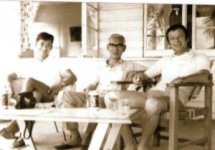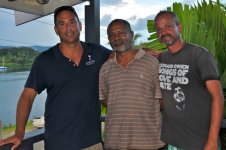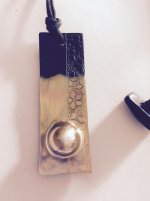You are using an out of date browser. It may not display this or other websites correctly.
You should upgrade or use an alternative browser.
You should upgrade or use an alternative browser.
Fiji J Hunter pearls Savusavu
- Thread starter kelluvpearls
- Start date
Red
Well-known member
- Joined
- Apr 8, 2012
- Messages
- 1,736
I can see myself wearing a Fire, Sand and Sea circled Fiji bracelet from the lot you are holding. It's all in the marketing. And, I will take color and luster over perfect shape any day. Simply gorgeous, and thank you so very much for showing us the harvest photos.
Bailey1856
Member
- Joined
- Apr 29, 2014
- Messages
- 580
Wow, they are out of this world beautiful!
la_corsetiere
Super Moderator
- Joined
- Jul 11, 2007
- Messages
- 1,046
Those colors really are amazing, Justin! I think the color often shows up better in circled pearls. Truly spectacular. Looking forward to experiencing the harvest in person one of these days! 
CathyKeshi
Well-known member
- Joined
- Mar 16, 2014
- Messages
- 4,706
Standing in the line for wildly colorful and incredibly, overwhelmingly gorgeous Circled and Keshi Fiji J. Hunter pearls ... please ...  Round may be perfection, but these are so much more interesting ... LOVE the photos, thanks Justin, and your wife.
Round may be perfection, but these are so much more interesting ... LOVE the photos, thanks Justin, and your wife.
JerseyPearl
Well-known member
- Joined
- Apr 25, 2014
- Messages
- 5,884
They look like little candies...those colors are so sweet!
kelluvpearls
Consumer
- Joined
- Jul 25, 2008
- Messages
- 1,291
Gorgeous pendant Tucs!
JerseyPearl
Well-known member
- Joined
- Apr 25, 2014
- Messages
- 5,884
That is a very cool blister! Interesting orientation, north and south...I might have been partial to a east-west display, but love it as presented here!
Justin Hunter
New Member
- Joined
- Sep 1, 2015
- Messages
- 53
The History of Fiji Pearls.

From what I understand and have read about the History of Pearling in Fiji:
There have been several attempts, mainly by Japanese companies, dating back to the 1950?s, to start pearling ventures in Fiji. Most of these attempts came under the Japanese ?Diamond Policy? (Pearls by Elisabeth Strack).
None of these companies really ?succeeded?. One individual however was very different then the rest of the companies coming into Fiji. He was and will always be known to me as Mr. Tokito. Mr. Tokito started his own pearling venture in the early 1960?s. He has never ?succeeded? in terms of producing the huge numbers of pearls, that pearling companies are always interested in, but he is still farming and has a wonderful family and really loves Fiji. (He has produced some exceptional pearls.)
Mr Tokito was absolutely instrumental to my growth and knowledge about pearling in Fiji. I?ve known Mr. Tokito since the mid 1990?s and have been very good friends with his son?s since the 1980?s.
Above is a rare picture of Mr. Tokito (far left), Mr. Wada, and Mr. Rosenthal. Mr. Tokito and Mr. Wada (master technician) had started a farm in Fiji in the very early 1960?s and had been producing some pearls. It was during these very early years that Mr. Tokito and Mr Wada were approached by Mr. Rosenthal (picture taken in Fiji at time of meeting).
Mr. Rosenthal and his brother were starting Tahiti?s first private sector pearl farm on Manihi atoll. The Rosenthal?s (famous French Family) had been tasked by France / French Polynesia to start French Polynesia?s first private pearl farm.
Both Mr. Tokito and Mr. Wada were asked to join the Rosenthal?s in Tahiti. Mr Wada eventually joined Mr. Rosenthal while Mr. Tokito stayed in Fiji.
Interesting to note that Mr Tokito said Mr Wada did not believe Fiji had enough oyster?s for a ?proper? pearling industry (true). But, Mr Tokito was happy to stay on and implant and harvest his own pearls and has had some 5 ? 7 different pearl farms all around Fiji over the last 40 years. He still farms, a little, and is always a great source for information and knowledge.
I started farming pearls in 1999. I was lucky to have quite a bit of aquaculture knowledge and extensive hatchery experience (Taylor Shellfish Farms, Washington State). We use both wild caught spat and hatchery shells to produce our pearls. Neither is consistent or easy.
Over the last 15 years I?ve seen probably 20 farms comes and go. Its just very complicated getting oysters, leases, and producing good quality pearls in Fiji.
Today J. Hunter Pearls Fiji works with two other local farmers; Civa Fiji owned by Claude and Danielle Prevost, and Valili Pearls, owned by local chief, Ratu Jone Maivalili. We all love what we do and take great pride in producing our unique Fiji Pearls. We work hand in hand to develop our industry.

Next Post will be back to pearls. We grade each line separately noting: technician, type of oyster, how and where oysters and pearls grew pre and post implant.
In several weeks I will have picks of the entire harvest.
Hope you enjoy.

From what I understand and have read about the History of Pearling in Fiji:
There have been several attempts, mainly by Japanese companies, dating back to the 1950?s, to start pearling ventures in Fiji. Most of these attempts came under the Japanese ?Diamond Policy? (Pearls by Elisabeth Strack).
None of these companies really ?succeeded?. One individual however was very different then the rest of the companies coming into Fiji. He was and will always be known to me as Mr. Tokito. Mr. Tokito started his own pearling venture in the early 1960?s. He has never ?succeeded? in terms of producing the huge numbers of pearls, that pearling companies are always interested in, but he is still farming and has a wonderful family and really loves Fiji. (He has produced some exceptional pearls.)
Mr Tokito was absolutely instrumental to my growth and knowledge about pearling in Fiji. I?ve known Mr. Tokito since the mid 1990?s and have been very good friends with his son?s since the 1980?s.
Above is a rare picture of Mr. Tokito (far left), Mr. Wada, and Mr. Rosenthal. Mr. Tokito and Mr. Wada (master technician) had started a farm in Fiji in the very early 1960?s and had been producing some pearls. It was during these very early years that Mr. Tokito and Mr Wada were approached by Mr. Rosenthal (picture taken in Fiji at time of meeting).
Mr. Rosenthal and his brother were starting Tahiti?s first private sector pearl farm on Manihi atoll. The Rosenthal?s (famous French Family) had been tasked by France / French Polynesia to start French Polynesia?s first private pearl farm.
Both Mr. Tokito and Mr. Wada were asked to join the Rosenthal?s in Tahiti. Mr Wada eventually joined Mr. Rosenthal while Mr. Tokito stayed in Fiji.
Interesting to note that Mr Tokito said Mr Wada did not believe Fiji had enough oyster?s for a ?proper? pearling industry (true). But, Mr Tokito was happy to stay on and implant and harvest his own pearls and has had some 5 ? 7 different pearl farms all around Fiji over the last 40 years. He still farms, a little, and is always a great source for information and knowledge.
I started farming pearls in 1999. I was lucky to have quite a bit of aquaculture knowledge and extensive hatchery experience (Taylor Shellfish Farms, Washington State). We use both wild caught spat and hatchery shells to produce our pearls. Neither is consistent or easy.
Over the last 15 years I?ve seen probably 20 farms comes and go. Its just very complicated getting oysters, leases, and producing good quality pearls in Fiji.
Today J. Hunter Pearls Fiji works with two other local farmers; Civa Fiji owned by Claude and Danielle Prevost, and Valili Pearls, owned by local chief, Ratu Jone Maivalili. We all love what we do and take great pride in producing our unique Fiji Pearls. We work hand in hand to develop our industry.

Next Post will be back to pearls. We grade each line separately noting: technician, type of oyster, how and where oysters and pearls grew pre and post implant.
In several weeks I will have picks of the entire harvest.
Hope you enjoy.
Justin Hunter
New Member
- Joined
- Sep 1, 2015
- Messages
- 53
do hatcheries now produce sufficient amounts of oysters in Fiji, Justin?
Bula Cees - answer is no. Black lip pearl oyster is very difficult to culture, numbers per run are low. Nursery stages - again difficult.
We also support the concept of purchasing wild caught spat from community spat farms.
Our oysters are not "dominant" in our environment, in fact very rare. So these don't really work very well either.
But we work with what we have.
Similar threads
- Replies
- 3
- Views
- 860
- Replies
- 9
- Views
- 926
- Sticky
- Replies
- 12
- Views
- 1K

